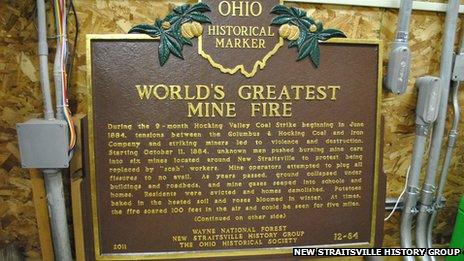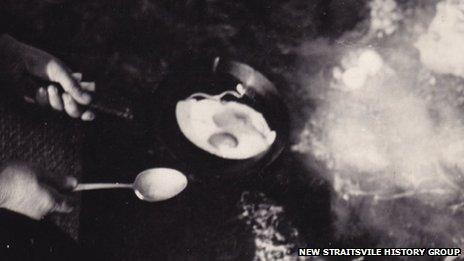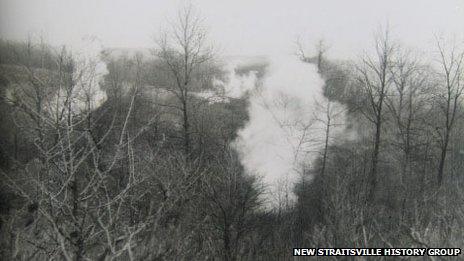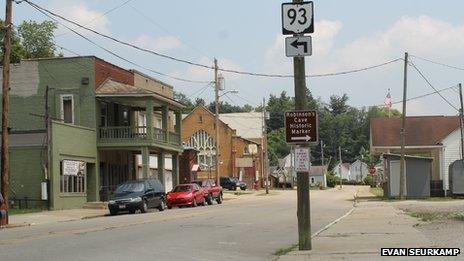How long can fires burn?
- Published

The compost fire in Beenham covered an area the size of a football pitch
It was declared a "public nuisance" but after burning for almost seven months the compost fire in Beenham, Berkshire, has finally been extinguished.
So, just how long can fires burn?
The blaze at the abandoned Good2Grow recycling centre started on 30 November last year and was put out on 21 June.
But that is no match for the world record for the longest-burning fire which is believed to have started around 5,000 years ago at a coal seam beneath Mount Wingen in New South Wales, Australia, and is still smouldering.
"Lightning struck the coal seam where it reached the Earth's surface," said a spokesman for Guinness World Records.
"Today, the fire is now burning around 30m (100ft) underground, as it has slowly eaten away at the seam."

In 2012, the New Straitsville History Group, Wayne National Forest and Ohio Historical Society dedicated a "historic marker" for a century-old blaze.

New Straitsville History Group said residents had been known to brew coffee straight from their wells because the soil was so warm, or even fry eggs over the fire holes.

In the 1930s, a barricade was built around New Straitsville in a bid to stop the fire and protect infrastructure in the town.

The underground blaze has become a "tourist feature" in the town, according to New Straitsville History Group.
In Hertfordshire, fire crews were on site for 15 days in Hemel Hempstead when a "deep-seated fire" burned in a large pile of recycled timber in November last year.
"How long can fires burn? How long is a piece of string?
"As long as there is a fuel supply and oxygen to supply it, a fire can burn indefinitely," said Steve Tant, policy support officer for the Chief Fire Officers' Association operations directorate.
He said the fire service would "never walk away" from a burning fire which is likely to endanger life, property or affect the economy.
Underground fires tend to burn longest, he said.
"They have the right conditions, particularly if they are on a coal seam where there is a constant fuel source.
"The dangers involved in trying to extinguish these types of fires - the risk to life, the environment, not to mention the sheer cost due to the millions of tonnes of water you would need - it's the Devil's own job to get them to go out."
In the US, a fire set in 1884 by striking miners in New Straitsville, Ohio is still burning underground.
Fried eggs
"It's now a tourist feature," said Laura Thrapp, president of New Straitsville History Group.
"Visitors ask how they can find it - we tell them to look for the smoke billowing up from the fire holes."
In the 1930s, the government intervened as the fire was beginning to spread to parts of the town. Residents were evacuated and homes demolished.
"A barricade was built around the town to try and stop it spreading - the old mine works were dug out and back-filled with clay," said Ms Thrapp.
"It should have worked but it did not, and in the 1970s one of the highways had to be moved because it kept sinking."

Daw Mill Colliery in Warwickshire closed following a fire in February which lasted several weeks
She said residents had been known to brew coffee straight from their wells because the soil was so warm, or even fry eggs over the fire holes.
It is estimated the fire, which is currently smouldering under nearby Wayne National Forest and does not pose a threat to infrastructure, could burn for at least another 100 years.
UK Coal said one of the biggest underground coal fires in the UK happened last year at Daw Mill Colliery near Coleshill in Warwickshire.
Gordon Grant, of UK Coal, said: "It lasted for several weeks and is regarded as one of the biggest fires the industry has seen for at least 30 years.
"It was described by the miners who tackled it as a 'raging inferno'."
He described the 50-year-old mining roadways underground as a "huge network".
"The oxygen supply was turned off the night the fire broke out, which gives you some indication of just how long it took that oxygen to disperse," he said.
Mr Grant added: "The main thing is no-one was injured."
- Published25 June 2013
- Published25 February 2013
- Published7 December 2012
- Published3 May 2011